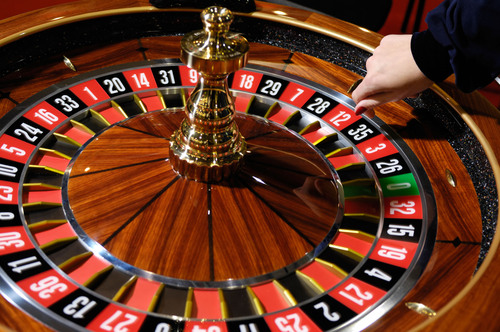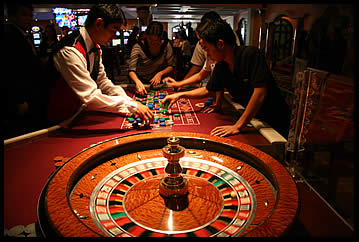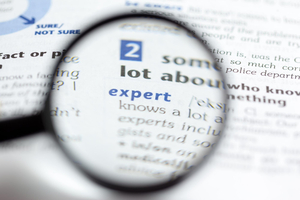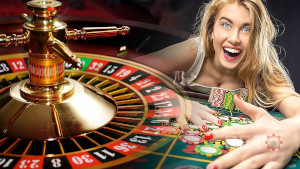Roulette Project

While in Vegas in 1998, attending the SEMA Conference (a very large aftermarket automotive conference), I became intrigued, fascinated, and ultimately hooked on the game of Roulette. Even though Einstein reportedly said that the only way to beat the game would be to steal money from the table, I quickly learned he was wrong. In fact, I'm a bit disappointed with him as a physicist, as he should have known that no manmade mechanical system can be perfect. Every such device will have flaws that can be exploited.
I began to study the game and found that there are three primary ways to beat it: Biased-Wheel detection, Dealer-Signature, and Ballistics. Biased-Wheel detection involves collecting lots of spin data on a wheel and using statistics to determine which, if any, numbers have a statistical bias and then exploiting those biases. It requires a lot of data (thousands of spins) and if anything changes the system, like if the wheel is moved or releveled, you throw your data out and start over. Once upon a time, this was a more viable technique, as manufacturing tolerances weren't as good as they are now, and wheel design and build technique was more subject to causing biases.
The second winning technique is Dealer-Signature. This works on the basis that the croupier running the wheel is going to get in a habit of spinning the wheel and ball at about the same speed each time, as they get in a rhythm from working shift after shift at the table. This means that the ball will travel about the same distance on each spin, which if you can compute that distance in some fashion, you can use it on the following spin to compute the ball fall-off location by using the numbers passing at the time of the spin, relative to the numbers passing that same reference point on the spin you did your calculations on, while assuming that the ball will once again travel about the same distance. This technique is valid and works in practice as long as you are quick enough to do your computations and get your bet placed before they call "no more bets".
The third, and most interesting, technique is ballistics. This can be done either visually by the bettor or by using a hidden computer. Numerically, this involves solving, in real-time, a second-order differential equation to compute the ball fall-off position, while taking into consideration friction and the quantizing effects of tilt, and then using chaos theory to predict the ball's path after it falls from the rim of the wheel and starts bouncing around to land in a numbered pocket. This is the technique utilized by the "Eudaemons", a collective composed of college students from UCSC in the early 1980's.
After reading the book "The Eudaemonic Pie" by Thomas Bass, which chronicles that team's adventures, I realized that the only problem they faced was the lack of computer technology in the early 1980's. Given modern technology, it's now much easier to achieve and that is the very crux of my "Roulette Project" -- to replicate the work of the Eudaemons, but without the large collective team and with modern technology.
After translating and reading the books by Pierre Basieux on this subject (which are written in German), I have since learned of a fourth winning technique. It's a technique that uses a paradox in reality itself in that nothing manmade can be completely perfect nor can it be completely random and chaotic. If man makes footprints, it's impossible for him to clean them up back to pure random chaos and not leave any traces behind. As such, reality itself ebbs and flows from clusters of order to chaos and then back again. And it's that ebb-and-flow that this fourth technique capitalizes on. There are many ways in which a system goes from chaos into a localized pattern of order, but only one way in which that order can sustain, which is by continuing to exist. To put it another way, it's just as improbable for a sequence of perfect coin tosses to be equally heads and tails as it is to be all heads or all tails.
While my passion, as an electrical engineer and software developer, is with the computerized form of ballistics, this fourth technique actually intrigues me the most. I really wished I would have translated the books by Pierre Basieux and learned of this fourth technique before he passed away in 2016, as I have many questions and details I wish I could discuss with him.
I have experimented with all four of these techniques to one-degree or another, and in live casino environments. My problem, as with all of my projects, is finding time to work on it. There's even less time to write up the details and publish it or post it online. Therefore, what you will find here is mostly just basic details on the game itself and is quite incomplete.
If you are interested in biased-wheel study, I highly recommend "The Biased Wheel Handbook" that I list with the books. For visual ballistics and the paradox of reality techniques, I highly recommend the works of Pierre Basieux. They are priceless resources.
Pierre also covers Dealer-Signature, but there are probably even better resources on that technique that I'm not aware of. So keep an eye open for whatever you might find. But, beware that many books and advertised "winning systems" are scams that are nothing but ways of presenting what's called classical roulette playing systems. Such systems may have short-term gains, but never have long-term sustained earnings. That is, they don't take the gamble out of playing roulette the way true winning system techniques do.
Also, the works of Edward Thorp, which are primarily on the ballistics technique, are priceless and highly recommended resources as well. And certainly you'll want to read "The Eudaemonic Pie" (a.k.a. "The Newtonian Casino") by Thomas Bass. It's a very fun and quick read. I've personally spoken with both the author, Thomas Bass, and with the main character of that book, Doyne Farmer. I think if I had a team ready to go to the casino today, Thomas Bass would be the first to volunteer to be on that team. Doyne Farmer, on the other hand, has moved on to stock market prediction and making computer software to do automatic trading, as it's apparently more profitable than beating the casino in roulette, though certainly not as much fun.
Roulette Information Center
Online Documents
 |
|






